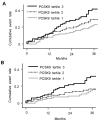Circulating PCSK9 Level and Risk of Cardiovascular Events and Death in Hemodialysis Patients
- PMID: 31963408
- PMCID: PMC7019341
- DOI: 10.3390/jcm9010244
Circulating PCSK9 Level and Risk of Cardiovascular Events and Death in Hemodialysis Patients
Abstract
Proprotein convertase subtilisin/kexin type 9 (PCSK9) is a promising new target for the prevention of cardiovascular (CV) events. However, the clinical significance of circulating PCSK9 is unclear in hemodialysis (HD) patients. A total of 353 HD patients were prospectively enrolled from June 2016 to August 2019 in a K-cohort. Plasma PCSK9 level was measured at the time of study enrollment. The primary endpoint was defined as a composite of CV event and death. Plasma PCSK9 level was positively correlated with total cholesterol level in patients with statin treatment. Multivariate linear regression analysis revealed that baseline serum glucose, albumin, total cholesterol, and statin treatment were independent determinants of circulating PCSK9 levels. Cumulative rates of composite and CV events were significantly higher in patients with tertile 3 PCSK9 (p = 0.017 and p = 0.010, respectively). In multivariate Cox-regression analysis, PCSK9 tertile 3 was associated with a 1.97-fold risk of composite events (95% CI, 1.13-3.45), and it was associated with a 2.31-fold risk of CV events (95% CI, 1.17-4.59). In conclusion, a higher circulating PCSK9 level was independently associated with incident CV events and death in HD patients. These results suggest the importance of future studies regarding the effect of PCSK9 inhibition.
Keywords: PCSK9; cardiovascular disease; hemodialysis.
Conflict of interest statement
The authors declare no conflict of interest.
Figures


References
-
- De Nicola L., Provenzano M., Chiodini P., D’Arrigo G., Tripepi G., Del Vecchio L., Conte G., Locatelli F., Zoccali C., Minutolo R., et al. Prognostic role of LDL cholesterol in non-dialysis chronic kidney disease: Multicenter prospective study in Italy. Nutr. Metab. Cardiovasc. Dis. 2015;25:756–762. doi: 10.1016/j.numecd.2015.04.001. - DOI - PubMed
LinkOut - more resources
Full Text Sources
Miscellaneous

